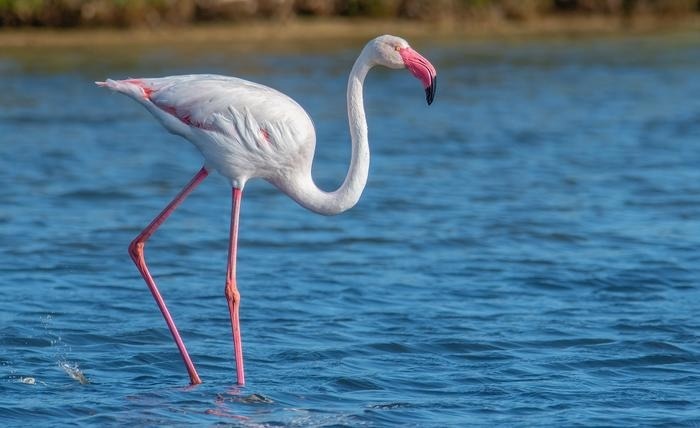A frozen chunk of genome has rewrote our understanding of the bird family tree.
 A greater flamingo in Mallorca, Spain. Unraveling a genetic mystery revealed that flamingos and doves are more distantly related than previously thought. Image Credit: Daniel J. Field
A greater flamingo in Mallorca, Spain. Unraveling a genetic mystery revealed that flamingos and doves are more distantly related than previously thought. Image Credit: Daniel J. Field
Scientists have spent generations attempting to classify and arrange about 10,000 species of birds into a single, distinct family tree to comprehend how the last remaining dinosaurs inhabited the skies. This should have been easy, as cheap DNA sequencing has proven to be for countless other species.
Scientists have discovered that an additional event that occurred 65 million years ago has deceived them about the true lineage of birds, as revealed in two new study articles published recently. They found that a portion of one chromosome was frozen in time for millions of years, preventing it from combining with neighboring DNA as it should have.
Scientists were persuaded that most birds could be divided into two main groups based only on this small portion of the bird genome, 2%, and that flamingos and doves were the evolutionary cousins of both groups. Four main groupings are identified in the more correct family tree, which also shows that flamingos and doves are more distantly connected. This family tree also explains the deceptive part of the genome.
My lab has been chipping away at this problem of bird evolution for longer than I want to think about. We had no idea there would be a big chunk of the genome that behaved unusually. We kind of stumbled onto it.”
Edward Braun, Ph.D., Study Senior Author and Professor, Department of Biology, University of Florida
The research was published in the journal Proceedings of the National Academy of Sciences.
Under the direction of Siavash Mirarab, a Computer Engineering Professor at the University of California, San Diego, Braun oversaw a global team of collaborators who published their evidence that this sticky bit of DNA obscured the real tale of bird development.
In addition, Mirarab and Braun were involved in a companion work headed by Josefin Stiller at the University of Copenhagen that was published in Nature and describes the updated bird family tree.
Both papers are part of the B10K avian genomics project headed by Guojie Zhang of Zhejiang University, Erich Jarvis of Rockefeller University, and Tom Gilbert of the University of Copenhagen.
Braun and his associates created a family tree for the Neoaves 10 years ago, a group comprising most bird species. They divided the Neoaves into two major groups, with flamingos and doves in one group and the remaining species in the other, based on the genomes of 48 different species.
This year, when a comparable study was conducted using 363 species, a different family tree that divided flamingos and doves into two separate groups surfaced.
The scientists set out to find an explanation that would allow them to determine which of the two mutually exclusive family trees was correct.
When we looked at the individual genes and what tree they supported, all of a sudden it popped out that all the genes that support the older tree, are all in one spot. That is what started the whole thing.”
Edward Braun Ph.D., Study Senior Author and Professor, Department of Biology, University of Florida
When Braun's team looked into this location, they found that despite millions of years of sexual reproduction, it was not as mixed as it should have been. Similar to humans, birds pass on genes from both parents to their progeny.
However, before generating sperm and eggs, humans and birds similarly combine the DNA they got from their parents. This process, known as recombination, ensures that no two siblings are exactly alike, maximizing the genetic diversity of a species.
Around the time the dinosaurs vanished, Braun's team discovered evidence that a little portion of a bird chromosome had blocked this recombination process for a few million years. It is uncertain if the chromosomal aberrations and the extinction catastrophe are connected.
As a result, in this fragment of frozen DNA, the flamingos and doves appeared to be alike. However, it became evident that the two groups were more distantly linked when the entire genome was considered.
What is surprising is that this period of suppressed recombination could mislead the analysis, and because it could mislead the analysis, it was detectable more than 60 million years in the future. That is the cool part.”
Edward Braun, Ph.D., Study Senior Author and Professor, Department of Biology, University of Florida
There may be more mysteries like this hidden in the genomes of other creatures.
Braun said, “We discovered this misleading region in birds because we put a lot of energy into sequencing birds’ genomes, and I think there are cases like this out there for other species that are just not known right now.”
Source:
Journal reference:
Mirarab, S., et al. (2024) A region of suppressed recombination misleads neoavian phylogenomics. PNAS. doi.org/10.1073/pnas.2319506121